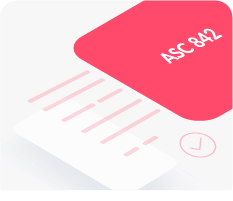
Right-of-use assets explained
By
EZLease team
Right-of-use (ROU) assets are a key feature when performing lease accounting for lessees. Before worrying about building a lease accounting compliance plan, it is a good idea to step back and explore the definition of what ROU assets is, and how it may pertain to your particular financial situation.
What are ROU assets?
A ROU asset is defined as a contractual right to use an underlying physical asset that has been leased from the owner (aka lessor) of the asset for use by the lessee throughout the duration of the lease period. Common examples of assets that fall into this category include but are not limited to office space, vehicles, heavy machinery, specialized tools, furniture, equipment and other similar items.
How is a ROU asset valued at lease commencement?
It is initially valued at the aggregate present value at lease commencement of all lease payments owed over the life of the lease.This would include periodic lease payments as well as estimated end of lease obligations that are reasonably certain, such as purchase option price (if the purchase option is reasonably certain to be exercised) and estimated payment to bridge any expected shortfall in residual value guarantee provided by the lessee to the lessor. Any initial direct costs (up front expenses that were incurred to consummate the lease) are added to the ROU asset. Any lease incentives (such as tenant improvement allowance) received from the lessor is deducted from the ROU asset.
Subsequent accounting for right-of-use assets
Under ASC 842, there can be two types of ROU assets: Finance and Operating. If a lessee is reasonably certain to consume substantially all of the economic value of the underlying asset over the lease term or if it is reasonably certain that the title to the underlying asset would transfer to the lessee at the end of the lease, it is classified as a Finance lease. Otherwise it is classified as an Operating lease.
For a finance lease, the ROU asset is amortized on a straight line basis, unless another amortization pattern better represents the utilization of the asset. If the title to the underlying asset is reasonably certain to transfer to the lessee at the end of the lease, the ROU asset is amortized over the total useful life of the asset consistent with the lessee’s depreciation policy for owned assets. Otherwise, the ROU asset is amortized over the shorter of the lease term or the useful life of the underlying asset.
For an operating lease, the total monthly expense is held constant over the life of the lease. This means that the amortization equals the difference between the constant monthly expense and the imputed interest on the lease liability. This results in an accelerating amortization pattern over time.
Under IFRS 16, GASB 87 and GASB 96, all leases on the balance sheet are accounted for as Finance leases. Consequently, the ROU asset is amortized on a straight line basis, unless another amortization pattern better represents the utilization of the asset. If the title to the underlying asset is reasonably certain to transfer to the lessee at the end of the lease, the ROU asset is amortized over the total useful life of the asset consistent with the lessee’s depreciation policy for owned assets. Otherwise, the ROU asset is amortized over the shorter of the lease term or the useful life of the underlying asset.
Subsequent reassessment of ROU asset
Like owned assets, ROU assets are also assessed for impairment periodically as well as on the occurrence of any event that is likely to materially impair the expected future benefits from the use of the asset. If it is concluded that such future benefit expected to be realized will be materially lower than the current net book value, an impairment is recorded to reduce the net book value of the ROU asset to its expected net realizable value.
The ROU asset is also remeasured if the lease is renewed or modified.
Key takeaways about right-of-use assets
Right-of-use assets are carefully regulated under the current lease accounting standards: ASC 842, IFRS 16, GASB 87 and GASB 96, and accounting departments must follow strict accounting standards to remain in compliance with the applicable accounting standard. Calculating and keeping accurate balance sheets that reflect right-of-use assets can be complex for businesses and government entities, but this process can be simplified with the right lease accounting software like EZLease.
Start your free trial of EZLease today to see how our software handles right-of-use assets and more. If you have any additional questions about the information covered here, please feel free to contact us.



